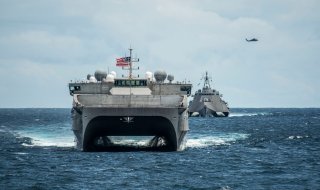Can This Boat Replace the Marines’ Light Amphibious Warship?
The Expeditionary Fast Transport ship performs a number of the amphibious missions designed for the emerging Light Amphibious Warship (LAW).
The U.S. Navy’s fast-evolving fleet of Expeditionary Fast Transport (EPF) ships will be a mission multiplier, allowing the Navy to support amphibious assault operations, conduct surveillance, and rapidly deliver high-value heavy armor and weapons.
“The EPF is designed to transport 600 short tons of military cargo 1,200 nautical miles at an average speed of 35 knots,” a U.S. Navy report written by Cap. Robert Locker, Jr. noted. The report added that “the ships are capable of operating in shallow-draft ports and waterways, interfacing with roll-on/roll-off discharge facilities and on/off-loading a combat-loaded Abrams Main Battle Tank.”
The EPF performs a number of the island-hopping amphibious missions designed for the emerging Light Amphibious Warship (LAW). The ability to transport numerous Abrams tanks offers a huge advantage to Navy and Marine Corps forces, as preparing and deploying heavily armored vehicles for land assault is typically extremely difficult. Now, with the EPF able to transport five main battle tanks, it will be much easier for the Navy to bring large combat vehicles from ship to shore, a massive advantage for amphibious attacks.
While the Marine Corps’ amphibious assault ships are designed to land and fight ashore, being able to fortify a land attack from the ocean changes the equation for commanders who might otherwise need weeks to prepare for a heavily-armored land invasion.
The Navy’s emerging Ship to Shore Connectors can transport Abrams tanks, but only one at a time. Having EPFs to transport Abrams tanks rapidly accelerates the process. A heavy armor attack from the sea enabled by EPFs could also help secure beachheads for massive follow-on attack forces.
Locker also suggests that, given the expected increase in demand for high-speed amphibious missions, the EPF might function as a longer-term supplement to the LAW. He also added that building additional ships may actually lower costs and improve Marine Corps operations. And while the EPFs are not intended to function as fully-armed combat vehicles, they are quite capable of supporting combat operations. What's more, the Navy’s thirteenth EPF recently underwent testing to develop autonomous capabilities for unmanned logistics missions, a ground-breaking development given that the high-speed vessel can transport up to 600 tons of equipment, troops, and weapons.
In the future, perhaps a large-scale amphibious assault would use EPFs carrying tanks, towed artillery, thousands of soldiers, and Optionally Manned Fighting Vehicle infantry carriers. Such an attack would happen in coordination with overhead F-35 and F-22 fighter air support, suppressive fire from land-attack Navy surface ships, and scores of Amphibious Assault Vehicles traveling from ship to shore.
Kris Osborn is the defense editor for the National Interest. Osborn previously served at the Pentagon as a Highly Qualified Expert with the Office of the Assistant Secretary of the Army—Acquisition, Logistics & Technology. Osborn has also worked as an anchor and on-air military specialist at national TV networks. He has appeared as a guest military expert on Fox News, MSNBC, The Military Channel, and The History Channel. He also has a Master’s Degree in Comparative Literature from Columbia University.
Image: Flickr/U.S. Navy.

